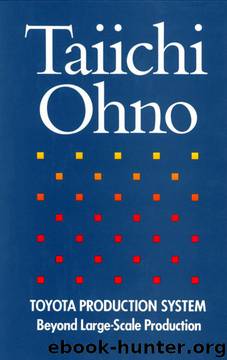Toyota Production System: Beyond Large-Scale Production by Taiichi Ohno & Norman Bodek

Author:Taiichi Ohno & Norman Bodek [Ohno, Taiichi & Bodek, Norman]
Language: eng
Format: epub
Tags: Business & Money, Management & Leadership, Production & Operations, Quality Control & Management, Quality Control, Engineering & Transportation, Engineering, Automotive, Industrial; Manufacturing & Operational Systems, Manufacturing, Medical Books, Administration & Medicine Economics, Health Care Delivery, Medical eBooks, Administration & Policy
Amazon: B003FLMPRC
Publisher: Productivity Press
Published: 1988-03-02T00:00:00+00:00
► 0. 1 Worker Is Still One Worker
In business, we are always concerned with how to produce more with fewer workers.
In our company, we use the term "worker saving" instead of "labor saving." The term "labor saving" is somehow easily misused in a manufacturing company. Labor-saving equipment such as the lift and bulldozer, used mainly in construction work, are directly connected to reducing manpower.
In automobile plants, however, a more relevant problem is partial and localized automation. For example, in work involving several steps, an automatic device is installed only at the last stage. At other points in the operation, work continues to be done manually. I find this kind of labor saving all wrong. If automation is functioning well, that is fine. But if it is simply used to allow someone to take it easy, it is too costly.
How can we increase production with fewer workers? If we consider this question in terms of the number of worker days, it is a mistake. We should consider it in terms of number of workers. The reason is that the number of workers is not reduced even with a reduction of 0.9 worker days.
First, work and equipment improvement should be considered. Work improvement alone should contribute half or one-third of total cost reduction. Next, autonomation, or equipment improvement, should be considered. I repeat that we should be careful not to reverse work improvement and equipment improvement. If equipment improvement is done first, costs only go up - not down.
The company newspaper reported on a talk I gave on worker saving. In the story, the term "labor saving" was printed in error as "using fewer workers. " But when I saw it, I thought, "This is true." "Using fewer workers" gets at the heart of the problem far better than "labor saving."
When we say "labor saving," it sounds bad because it implies eliminating a worker. Labor saving means, for example, a job that took 10 workers in the past is now done by eight workers - eliminating two people.
"Using fewer workers" can mean using five or even three workers depending on the production quantity - there is no fixed number. "Labor saving" suggests that a manager hires a lot of workers to start with, reducing the number when they are not needed. "Using fewer workers," by contrast, can also mean working with fewer workers from the start.
In actual experience, Toyota had a labor dispute in 1950 as a result of reducing its workforce. Immediately after its settlement, the Korean War broke out and brought special demands. We met these demands with just enough people and still increased production. This experience was valuable and, since then, we have been producing the same quantity as other companies but with 20 to 30 percent fewer workers.
How was this possible? In short, it was the effort, creativity, and power of its people that enabled Toyota to put into practice the methods that ultimately have become the Toyota production system. And this is not just an expression of conceit.
Download
This site does not store any files on its server. We only index and link to content provided by other sites. Please contact the content providers to delete copyright contents if any and email us, we'll remove relevant links or contents immediately.
| Automotive | Engineering |
| Transportation |
Whiskies Galore by Ian Buxton(41937)
Introduction to Aircraft Design (Cambridge Aerospace Series) by John P. Fielding(33092)
Small Unmanned Fixed-wing Aircraft Design by Andrew J. Keane Andras Sobester James P. Scanlan & András Sóbester & James P. Scanlan(32763)
Craft Beer for the Homebrewer by Michael Agnew(18195)
Turbulence by E. J. Noyes(7977)
The Complete Stick Figure Physics Tutorials by Allen Sarah(7336)
Kaplan MCAT General Chemistry Review by Kaplan(6899)
The Thirst by Nesbo Jo(6877)
Bad Blood by John Carreyrou(6581)
Modelling of Convective Heat and Mass Transfer in Rotating Flows by Igor V. Shevchuk(6406)
Learning SQL by Alan Beaulieu(6237)
Weapons of Math Destruction by Cathy O'Neil(6214)
Man-made Catastrophes and Risk Information Concealment by Dmitry Chernov & Didier Sornette(5952)
Digital Minimalism by Cal Newport;(5702)
Life 3.0: Being Human in the Age of Artificial Intelligence by Tegmark Max(5510)
iGen by Jean M. Twenge(5384)
Secrets of Antigravity Propulsion: Tesla, UFOs, and Classified Aerospace Technology by Ph.D. Paul A. Laviolette(5332)
Design of Trajectory Optimization Approach for Space Maneuver Vehicle Skip Entry Problems by Runqi Chai & Al Savvaris & Antonios Tsourdos & Senchun Chai(5037)
Pale Blue Dot by Carl Sagan(4952)
